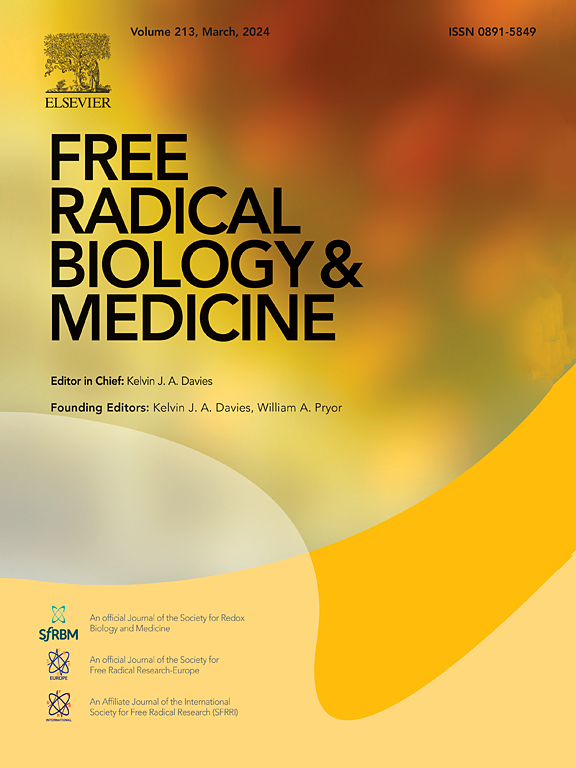在新诊断的双相情感障碍患者及其未受影响的一级亲属中,丙二醛作为与家族风险相关的特征标志物的研究-一项纵向队列研究
IF 7.1
2区 生物学
Q1 BIOCHEMISTRY & MOLECULAR BIOLOGY
引用次数: 0
摘要
目的:氧化应激引起的组织损伤增加似乎在双相情感障碍(BD)的病理生理和进展中起关键作用。丙二醛(MDA)是脂质氧化的产物,可能是与家族风险相关的BD特征标志物。然而,MDA在新诊断的双相情感障碍(BD)患者及其未受影响的亲属(UR)中的研究很少。方法:在这项前瞻性的“双相情感障碍发病研究”中,我们对371名新诊断/首发双相情感障碍患者(1016次就诊)、139名未受影响的一级亲属(307次就诊)和199名没有个人或一级家族情感障碍病史(537次就诊)的健康对照(HC)进行了MDA的重复测量,中位随访时间为2.0。BD患者为[0.1;3.8]年,UR患者为1.4[0;2.4]年,HC患者为2.5[1.1;3.9]年。在双相障碍患者中,我们进一步研究了MDA与情感期、药物和疾病变量在7年内的关系。结果:经性别和年龄校正的多重比较,未受影响的亲属在基线时的MDA水平比HC高42.3% (B = = 1.423, 95% CI = 1.139, 1.777, p =)结论:与预期相反,我们的研究结果不支持脂质氧化增加是BD的一种特征现象。本文章由计算机程序翻译,如有差异,请以英文原文为准。

Investigation of malondialdehyde as a trait marker associated with familial risk in patients with newly diagnosed bipolar disorder and their unaffected first-degree relatives – A longitudinal cohort study
Aims
Increased oxidative stress-generated tissue damage seems to play a pivotal role in the pathophysiology and progression of bipolar disorder (BD). Malondialdehyde (MDA), a product of lipid oxidation, may represent a trait marker in BD associated with familial risk. However, MDA is scarcely studied in patients with newly diagnosed bipolar disorder (BD) and their unaffected relatives (UR).
Methods
In this prospective "the Bipolar Illness Onset study", we investigated repeated measurements of MDA in a cohort of 371 patients with newly diagnosed/first-episode BD (1016 visits), 139 of their unaffected first-degree relatives (307 visits) and 199 healthy control individuals (HC) with no personal or first-degree family history of affective disorder (537 visits) with a median follow-up time of 2.0. [0.1; 3.8] years for patients with BD, 1.4 [0; 2.4] years for UR, and 2.5 [1.1; 3.9] years for HC. Amongst patients with BD, we further investigated associations of MDA with affective phases and medicine- and illness variables over a period of 7 years.
Results
Unaffected relatives had 42.3 % higher levels of MDA at baseline compared with HC in analyses adjusted for sex and age corrected for multiple comparisons (B = = 1.423, 95 % CI = 1.139, 1.777, p = <0.044). However, this difference did not persist over time. No statistically significant differences in MDA levels were observed over time between BD patients and either HC or UR. Additionally, MDA levels were not associated with psychotropic use, illness variables, or affective phase alterations.
Conclusions
Against expectations, our findings did not support increased lipid oxidation being a trait phenomenon in BD.
求助全文
通过发布文献求助,成功后即可免费获取论文全文。
去求助
来源期刊

Free Radical Biology and Medicine
医学-内分泌学与代谢
CiteScore
14.00
自引率
4.10%
发文量
850
审稿时长
22 days
期刊介绍:
Free Radical Biology and Medicine is a leading journal in the field of redox biology, which is the study of the role of reactive oxygen species (ROS) and other oxidizing agents in biological systems. The journal serves as a premier forum for publishing innovative and groundbreaking research that explores the redox biology of health and disease, covering a wide range of topics and disciplines. Free Radical Biology and Medicine also commissions Special Issues that highlight recent advances in both basic and clinical research, with a particular emphasis on the mechanisms underlying altered metabolism and redox signaling. These Special Issues aim to provide a focused platform for the latest research in the field, fostering collaboration and knowledge exchange among researchers and clinicians.
 求助内容:
求助内容: 应助结果提醒方式:
应助结果提醒方式:


